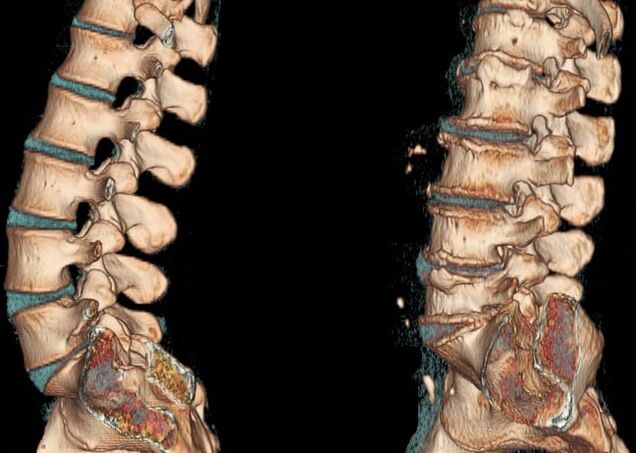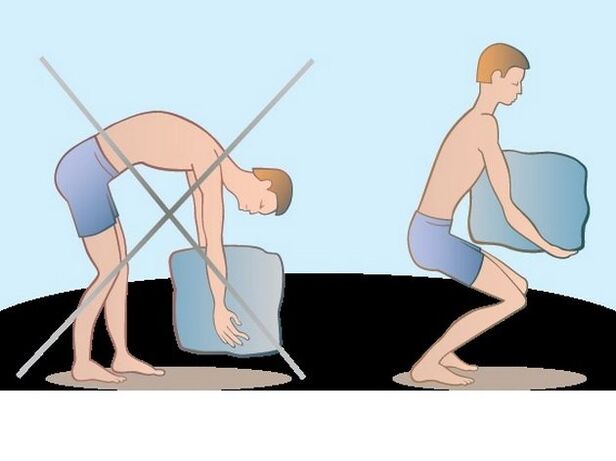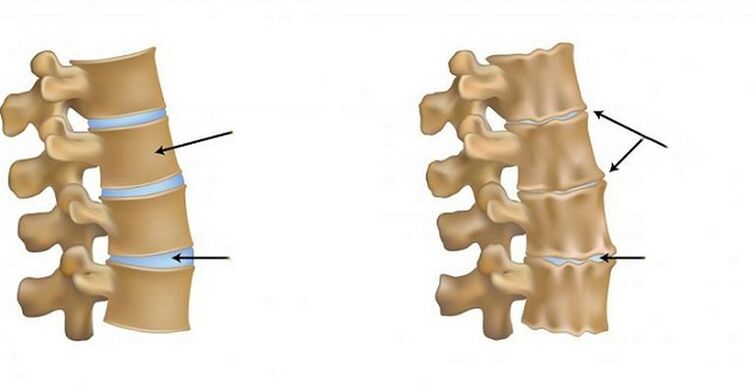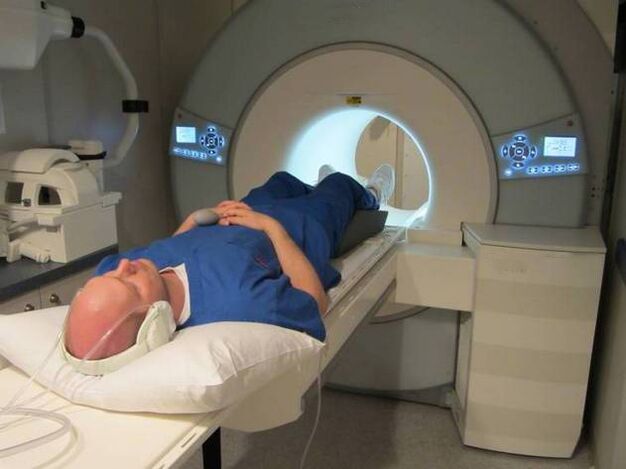
People with osteochondrosis of the lumbar spine always avoid sudden movements, carefully support and return to the sides, slowly sit, rise.So they try to prevent sharp pain, drilling on their backs, forcing them to freeze in a body position.Osteochondrosis is also manifested by crisis, clicks, mobility restrictions.Its treatment is most often conservative, but with severe damage to discs and vertebrae, surgical intervention is required.
What is lumbar back osteochondrosis
Lumbar osteochondrosis is a degenerative-district pathology, which initially affects the intervertebral discs.Due to insufficient nutrient intake, they lose the ability to maintain moisture.Regeneration processes slow down, discs become flat, fragile.The distance between the adjacent vertebrae is reduced, therefore, bone tissue grows to stabilize the lumbar segment affected by osteochondrosis.Osteophytes are formed - bone growths, with the displacement of which soft tissue structures, nerve roots, blood vessels are sore.
Stages of pathology
The stage of osteochondrosis is the stage of development of the disease, which is characterized by some destructive changes in the discs and bodies of the vertebrae.It is established using an X -Rrey exam.In the resulting images, the specific signs of destruction of vertebral structures are clearly visible.Each stage corresponds to the severity of osteochondrosis, a set of symptoms.The higher it is, the more difficult the disease gives itself conservative treatment.
| Phase of lumbar osteochondrosis | X -Ray features and clinical manifestations |
| First (pre -clinic) | There are no signs of osteochondrosis in radiographs.Occasionally has unpleasant sensations in the lower back after physical exercise or long -term standing |
| Second | There is a correction of lordosis, less often - vertebral bodies scenes, deformation of semi -munitions.The height of the discs is slightly reduced.Painful sensations appear more often, their duration increases |
| Third | , Subcondral sclerosis of the closing plaques, damage to a large number of semi -munitions and a moderate decrease in disc heal are observed.In addition to pain in the lumbar region, the clinic contains a stalemate, stiffness of movements |
| Fourth | Half processes -munitions are rejected from the outside and posteriorly.There is a compensatory increase in bone tissue, the formation of multiple osteophytes.Pain occurs when moving and at rest |
Causes of the disease

The causes of the development of osteochondrosis have often increased loads on the lumbar spine.The discs are constantly microtrauma, having no time to recover in a timely manner.An important part is gradually damaged, starting to deform bone bodies of the vertebrae.Such pathological conditions are also capable of provoking the destruction of the lumbar segment:
- Congenital or acquired abnormalities - flat feet, scoliosis, kyfosis, valgus foot deformity, tbs dysplasia;
- Systemic pathologies - rheumatoid arthritis, scleroderma, red lupus;
- Endocrine and metabolic diseases- diabetes mellitus, hypo- and hyperthyroidism, overweight;
- Previous injuries - subluxation of vertebrae and their fractures, spinal cord damage;
- Disordishes of circulatory circulation, including against the backdrop of a sedentary lifestyle.
One of the main causes of osteochondrosis is the natural aging of the body.After 50 years, recovery processes slow down, collagen production decreases, the condition of the ligaments worsens.
Characteristic signs and symptoms of the disease
In the initial stage of development, osteochondrosis does not appear clinically.A person takes poor pain for the lower back for muscle overdose after a day of work and is not consulted with a doctor.But the severity of the symptoms is slowly increasing - soon a crisis with tilts and curves of the matter, sensitivity disorders and stiffness join pain.
Novice syndrome
This is the name of the loss of spinal roots, which leads to motor, vegetative and severe disorders.Rotor syndrome develops with osteochondrosis of severity 3-4.In these stages, an intervertebral hernia is formed, compressing the spinal roots.The pathology continues according to the type of Lumbago, Lumbalgia and Lumbar -lgia.In addition to severe pain, radicular syndrome is characterized by numbness of numbness, tingling, creeping pins, decreasing or complete lack of sensitivity.
Ischemic syndrome

In the late stages of the lumbar osteochondrosis flow, it is possible to compress large herniac blood vessels.The pelvic organs cease to take a sufficient amount of nutrients, which leads to a violation of their functioning.The cerebral cerebral trophy is also upset, a neurological deficiency develops - a permanent dementia, fever, sensitivity of pain falls.
Vertebral syndrome
As a result of the reduction of the distance between the adjacent bodies of the vertebrae, the growth of bone tissue, the vertebral lumbar segments gradually deform.The situation is exacerbated by the constant compensatory stress of the back muscles with their later atrophy.Pathologically changes a person's walking and behavior, including due to improper redistribution of loads.The possibility of incorporating other parts of the spine and foot joints in the destructive-depressant process has increased significantly.
Pain syndrome
At the bottom of the back is a large sciatica formed by the sacral spinal roots.When it is violated with hernial extension, bone growth, spasmodic muscles, Ishias occur - a typical symptom of lumbar osteochondrosis.There is an acute pain that spreads along the sciatica in the hips, knees, lower legs (lumbar -lgia).Another specific feature of the pathology - lumbago, or "shots" at the bottom of the back after a sharp tendency or twist, hypothermia.
Diagnostic methods

When making a diagnosis, the radiographic photos taken in two projections are more informative.To study in more detail the affected lumbar segment, an MRI is performed.The study allows you to evaluate the condition of the spinal cord, soft tissue structures, blood vessels, nerve roots.It is possible to determine the rate of damage to nerve drawers using the potentials caused, electronography, electromography.Discography is used to aim to examine the affected disks.
How is the treatment performed
A comprehensive approach to therapy for lumbar osteochondrosis is practiced.Treatment is aimed at eliminating pain, restoring volume of movements, preventing the spread of pathology in healthy discs and beads.
drug
The use of non -inflammatory drugs non -inflammatory, glucocorticosteroids, muscle relaxants allows you to get rid of back pain.In therapy, medicines are used to improve blood circulation.Patients should prescribe group B vitamins, chondroprotectors.
Physical education
This is the most effective and affordable treatment for osteochondrosis.After 1-2 months of daily treatment of physiotherapy exercises, not only the lower back muscles, but the entire back, improve behavior, accelerate blood supply to damaged connective tissue structures.LFK doctors recommend that patients recommend slow and sloping toasted curves, shallow and lungs.
Massage
Patients with lumbar osteochondrosis indicate all types of massage - vacuum, acupuncture, connective, segmental.But mostly in demand is classic.During the session, the massage therapist performs the main massage movements: stroke, rubbing, cooking, vibration.The goals of the procedures are to eliminate muscle cramps, improve blood circulation in the affected segment and strengthen skeletal muscles.
Physiotherapy
In an acute and subacute period, patients are prescribed by electrophoresis or ultraphonophoresis with glucocorticosteroids, anesthetics, vitamins B in the group.At the stage of remission, laser therapy, magnetotherapy, stressed wave therapy and UHF therapy are often performed.Ozokeritoling, paraffin applications, hirudotherapy, mud, radon, hydrogen sulfur baths are also used.
Surgical intervention
The main story of surgical intervention is the spinal cord violation with hernial extension.During surgery, intervertebral hernia is removed, spinal canal decompression is performed.The most commonly used methods of surgical intervention for lumbar osteochondrosis are microdiscectomy, puncture evaporation or disk laser reconstruction, implant installation, vertebral segment stabilization.
Traditional medicine
After the main therapy, the achievements of sustainable prayer in the treatment, house -made oil, herbal teas, compresses, oil friction and alcohol are used.Popular remedies do not affect the cause of osteochondrosis, so they are used to eliminate poor, painful pain, severity in the lower hypothermia, a sharp weather change or increased physical activity.
The consequences of lack of treatment
The development of almost all complications of lumbar osteochondrosis is provoked by the formed intervertebral hernia.Discogenic myelopathy is particularly dangerous, which does not always result in surgical treatment.It is manifested by pelvic disorders, including defecation disorders, urination.Complications of osteochondrosis also include Rooseer's syndrome - a common cause of acute pain, drilling into the back.
Prevention and forecasting measures
The prognosis is favorable in diagnosing the pathology of 1-2 degrees of severity.It gives itself a well -known conservative treatment, and in young patients it is even possible to partially restore the tissue of the intervertebral disc.With the development of complications, the forecast for complete recovery is less favorable.
Prevention of lumbar back osteochondrosis is to control body weight, exclusion of excess loads, timely treatment of endocrine, metabolic diseases.Neurologists and vertebologists recommend visiting the pool, getting involved in aquerobics, pilates, Scandinavian walking.



















